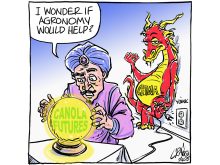THE United States Department of Commerce is expected to announce the preliminary results Oct. 15 of an investigation into whether Canadian hogs have been dumped in the U.S. – sold at an average price below the cost of production.
It’s the second prong on the fork with which American pork producers hoped to skewer their Canadian counterparts. The first prong, an investigation into international trade compliance of Canada’s support programs, showed that Canada is playing by the rules.
Wounded by that defeat, the National Pork Producers Council in the U.S. is now taking another stab. It is calling for an end to all federal government subsidies to Canadian hog producers, including income stabilization programs designed to support all farmers.
Read Also

Pork doing the right thing
Manitoba’s pork industry gives the province a lot to be proud of.
John Caspers, past-president of the NPPC, claims that federal subsidies guarantee an income to Canadian hog farmers, that “their government guarantees them an income no matter what.”
Yet one doesn’t need a particularly long memory to recall hard times in the hog industry that saw many producers leave the business, unable to make a living in this risky industry.
These continual servings of American angst over Canadian exports are becoming ever more difficult to swallow – by hog producers and by the public.
Manitoba Pork Council general manager Ted Muir calls the NPPC “unrelenting,” and clearly fears the American group may never support the free and fair trade it claims to espouse.
In a report on the swine situation, the George Morris Centre think tank suggests the NPPC’s latest criticism of Canadian agricultural policy puts it in the same realm as the cattle group R-CALF, whose goal is “to bring attention to itself by trying to impede trade at the expense of rational thought.”
The hog industry, like most other agricultural industries in Canada, has worked to eliminate government programs that encourage overproduction. Yet every change in the market that runs counter to U.S. profits inevitably draws accusations from farm groups about some perceived inequity.
Ask though they might for a level playing field, it appears several U.S. groups instead would prefer a field slanted permanently in favour of their own competitive position in the marketplace.
Indeed, who wouldn’t? Yet trade agreements are not matters of convenience, to be ignored when trade conditions don’t suit one of the signatories.
Regardless of the Oct. 15 ruling, we cannot expect U.S. factions to stop dishing out challenges. We know by now that increased exports of any commodity into the U.S. will raise hackles.
The lesson we’ve been slow to learn, to our detriment, is that goals to expand markets of any kind must be based on diverse targets. Canadian producers must be aggressive in market development, look beyond the giant next door and explore export opportunities wherever they can be found.
















